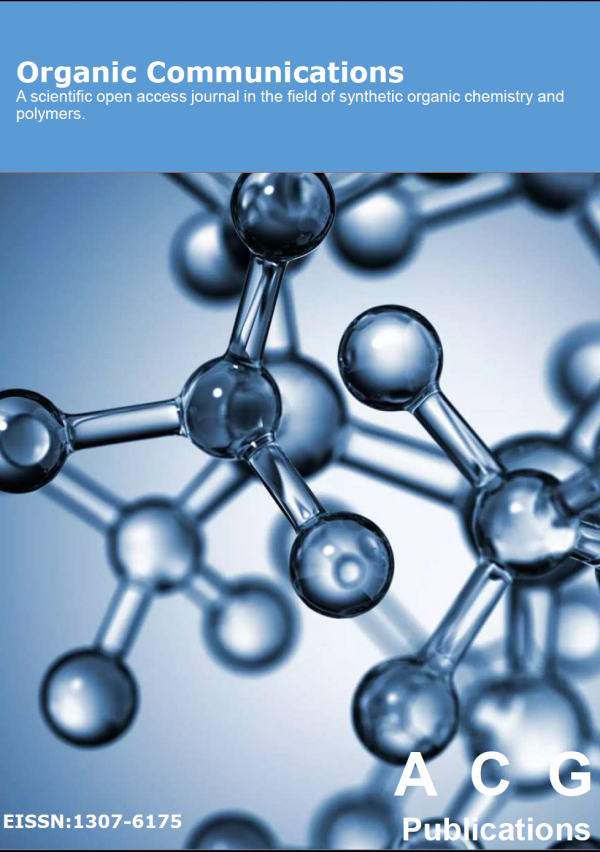Organic Communications
Year: 2009 Volume: 2 Issue:2 April-June
1) Iodine catalyzed and tertiary butyl ammonium bromide promoted p reparation of b enzoxazaphosphininyl phenylboronates
Benzoxazaphosphininyl Phenylboronates were prepared by O -Phosphorylation of potassium salt of phenylboronic acid with cyclic phosphoromonochloridates in the presence of stoichiometric amount of Iodine and catalytic amount of tertiary butyl ammonium bromide at 50-60 °C in dry toluene.
Keywords Phosphaphenylboronates O-Phosphorylation Iodine tertiary butyl ammonium bromide DETAILS PDF OF ARTICLE © 2009 ACG Publications. All rights reserved.2) Glycerol as an alternative green medium for carbonyl compound reductions
Glycerol was employed as an alternative green reaction medium in various carbonyl reduction methodologies. The high polarity of glycerol allowed for the simple reduction of different carbonyl compounds with sodium borohydride and the enantioselective reduction of ethyl acetoacetate with both Ru-BINAP and baker's yeast. As a solvent, glycerol also allowed electro-reduction and microwave assisted reactions.
Keywords Asymmetric hydrogenation glycerol green chemistry metal hydride reduction DETAILS PDF OF ARTICLE © 2009 ACG Publications. All rights reserved.3) A new Synthesis of 3-arylpropenoic acids and 5-phenyl-2,4-pentadienoic acid from 4-acetyl-3-arylsydnones and arylaldehydes
The 3-aryl-(4-cinnamoyl)sydnones 3a-l obtained from 4-acetyl-3-arylsydnones 2a-d and arylaldehydes, on hydrolysis with conc.H 2SO 4 under mild conditions yielded the 3-arylpropenoic acids 4a-c. Reusable 3-arylsydnones 1a-d were also recovered. This simple and practical synthesis was also applied to the preparation of 5-phenyl-2,4-pentadienoic acid 6.
Keywords 3-Aryl-(4-cinnamoyl)sydnones 3-Arylpropenoic acids 5-Phenyl-2 4-pentadienoic acid DETAILS PDF OF ARTICLE © 2009 ACG Publications. All rights reserved.4) Synthesis of benzimidazol-2-thiones from dimedone : An unexpected cyclisation into a five-membered ring
When enaminones 9 obtained from dimedone were used instead of furanone 3 and pyranone 4 in the reaction with carbon disulfide in presence of pyridine, a crystalline product was formed whose spectral data and X-Ray structure were inconsistent with the benzodiazepine-thiones 5-6 but agreed with the structure of benzodimidazol-2-thione 11 which is expected to possess a notable pharmacological activities. Theoretical calculations, with DFT/B3LYP method, have been carried out to rationalize the experimental results.
Keywords Dimedone enaminones benzimidazol-thiones benzodiazepines carbon disulfide DETAILS PDF OF ARTICLE © 2009 ACG Publications. All rights reserved.5) Solvent and electronic effects on kinetics of cyclization of thermolabile aryllithium reagents. A comparison between 1-bromo-2-(2-bromoethyl)benzene and 4,5-dimethoxy-1-bromo-2-(2-bromoethyl)benzene
A dramatic solvent effect on the stability and kinetics of intramolecular cyclization is described for the aryllithium species generated from 2-bromo-4,5-dimethoxy-(2-bromoethyl)benzene. The aryllithium generated by the halogen-metal exchange reaction with n-butyllithium, is stable for > 1h when generated at -95 to -100 oC in diethyl ether/hexane and can be trapped with electrophiles. However, when the reaction is conducted in a THF/hexane mixture, the intermediate undergoes instantaneous intramolecular cyclization to afford 4,5-dimethoxybenzocyclobutene. By comparison, the corresponding 1-lithio-2-(2-bromoethyl)-benzene intermediate is stable for >1h in either THF/hexane or diethyl ether/hexane at -95 to -100 oC. These results indicate that substituent effects as well as the nature of aggregation of these intermediates play key roles in determining the reaction pathway of functionalized aryllithium intermediates when quenched with electrophiles.
Keywords Functionalized aryllithium lithium-halogen exchange kinetics solvent effects DETAILS PDF OF ARTICLE © 2009 ACG Publications. All rights reserved.